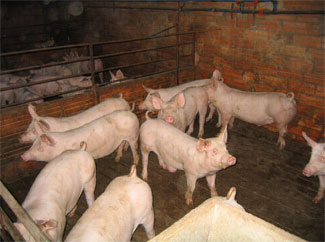Swine and bacteria

Haemophilus parasuis infections produce big losses in swine populations. This bacterium is a respiratory pathogen of pigs, whose strains differ in several features, including pathogenic potential. It produces Glässer's disease, an invasive disease which is characterized by polyserositis, arthritis and meningitis, but it is also involved in other pathological outcomes, such as pneumonia and sudden death.
In addition, strains of H. parasuis colonize de upper respiratory tract of pigs at a very young age and it can be isolated from the nose of healthy pigs. Thus, it can be found in all commercial farms as part of the normal respiratory microbiota of the pigs and, in a given farm, several strains of H. parasuis can be isolated. In healthy farms is normal to have a variety of H. parasuisstrains, which through balance with the immunity of the pigs do not generate disease. The introduction of new virulent strains can break this balance and produce an outbreak. However, it is not known how an outbreak and the subsequent antibiotic treatment affect the population of H. parasuis strains.
In this study, a farm was studied during an outbreak of Glässer's disease and 1 year after antimicrobial treatment and elimination of clinical signs. Antimicrobial susceptibility, serotype and genotype of the strains were determined. Two different genotyping techniques were used: enterobacterial repetitive intergenic consensus (ERIC)-PCR, which is based in the comparation of band patterns; and multilocus sequence typing (MLST), which is a sequencing technique developed previously by our group.
In October of 2004, the farm suffered an outbreak of Glässer's disease. Several lungs were sent to the laboratory (Laboratorio Veterinario de Diagnosis de Enfermedades Infecciosas, UAB) and one H. parasuis strain was isolated. This strain was grouped with other virulent strains by MLST and serotyping. Treatment with antibiotic was applied and eliminated the strain, but the problems moved to older animals. At this time, samples were taken from the affected unit in the farm and only one strain of H. parasuis, which was resistant to the treatment, could be isolated. Thus, the antimicrobial treatment reduced the diversity of strains isolated in the affected animals. However, after 1 year without clinical problems, we isolated 3 different strains of H. parasuis from the nose of the animals in this farm, showing that the variability of strains was back to normal.
References
Olvera, A; Cerda-Cuellar, M; Nofrarias, M; Revilla, E; Segales, J; Aragon, V "Dynamics of Haemophilus parasuis genotypes in a farm recovered from an outbreak of Glasser's disease". VETERINARY MICROBIOLOGY, 123 (1-3): 230-237 JUL 20 2007


